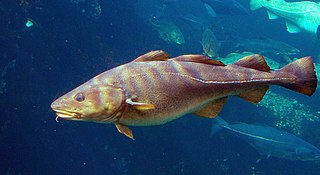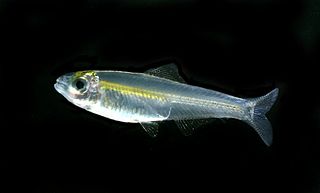
Cod is the common name for the demersal fish genus Gadus, belonging to the family Gadidae. Cod is also used as part of the common name for a number of other fish species, and one species that belongs to genus Gadus is commonly not called cod.

Clupeidae is a family of clupeiform ray-finned fishes, comprising, for instance, the herrings and sprats. Many members of the family have a body protected with shiny cycloid scales, a single dorsal fin, and a fusiform body for quick, evasive swimming and pursuit of prey composed of small planktonic animals. Due to their small size and position in the lower trophic level of many marine food webs, the levels of methylmercury they bioaccumulate are very low, reducing the risk of mercury poisoning when consumed.

Sprat is the common name applied to a group of forage fish belonging to the genus Sprattus in the family Clupeidae. The term also is applied to a number of other small sprat-like forage fish. Like most forage fishes, sprats are highly active, small, oily fish. They travel in large schools with other fish and swim continuously throughout the day.

The European sprat, also known as brisling, brisling sardine, bristling, garvie, garvock, Russian sardine, russlet, skipper or whitebait, is a species of small marine fish in the herring family Clupeidae. Found in European, West Asian and North African waters, it has silver grey scales and white-grey flesh. Specific seas in which the species occurs include the Irish Sea, Black Sea, Baltic Sea and Sea of the Hebrides. The fish is the subject of fisheries, particularly in Scandinavia, and is made into fish meal, as well as being used for human consumption. When used for food it can be canned, salted, breaded, fried, boiled, grilled, baked, deep fried, marinated, broiled, and smoked.

The Australian sprat is a sprat fish whose habitat ranges in the waters surrounding Australia including Tasmania. It is a pelagic fish which is found in anti-tropical, temperate water. It is a part of the Clupeidae family. Other members of the Cluepeidae family also include herring, menhaden, sardines as well as shads. It is currently a relative unknown species of Sprat compared to the other members of the family. In total, there are five different types of True Sprats. What makes Australian Sprats different from the rest is their location and appearance. Sprattus Novaehollandiae have a dark blue back and a protruding lower jaw. They are found in the Southern regions of Australian such as lower Victoria and Tasmania were there are colder climates. On average, Australian Sprat grown up to 14 cm and live in the range of 0–50 meters deep in the ocean. They will lay between 10,000 and 40,000 eggs per year and live for approximately 5–7 years. Other names for the Australian Sprat include Clupea Bassensis and Meletta Novaehollandiae.

The New Zealand blueback sprat is a herring-like, forage fish of the family Clupeidae found in the waters around New Zealand, between latitudes 37° S and 48° S, and longitude 166° E and 180° E, to depths of up to 50 m. It belongs to the genus Sprattus, a small oily fish usually known by their common name, sprats. Its length is up to 12 cm.

The New Zealand sprat is a herring-like, marine fish in the family Clupeidae found in the subtropical southwest Pacific Ocean endemic to New Zealand. It belongs to a genus Sprattus of small oily fish, usually known by their common name, sprats.

The sandy sprat, Hyperlophus vittatus, also known as the glassies, glassy, white pilchard, or whitebait, is a type of sprat fish.

The glassy sprat is a type of sprat fish. The fish, when alive, is translucent, so it gets the second word in its scientific name from the Latin word translucidus, meaning transparent, diaphanous. In animal classification the glassy sprat belongs to Osteichthyes, Clupeiformes, Clupeidae, Hyperlophus. The glassy sprat is native to Australia and mainly found in Australia. It is marked as NE because it has not yet been evaluated by the World Animal Protection. It is mainly used as an economical aquatic product. In ecosystems, they are at the bottom end of the food chain, feeding mainly on plankton, which are less aggressive and very vulnerable to other fish. Glassy sprat are tiny in size and translucent with a silvery streak that extends from its tail to just behind its head. As early as a hundred years ago, Australians harvested the glassy sprat in large quantities and it featured on the table as food for a long time. Due to its poor appearance, it is not a very good ornamental fish.

Clupeoides is a genus of sprats that occur in rivers in Southeast Asia. There are currently four recognized species in the genus.

Clupeonella is a genus of fish in the family Clupeidae. They are widespread in the fresh and brackish waters of the Caspian Sea and Black drainages.

Lankiam Cay, also known as Panata Island, is the smallest of the naturally occurring Spratly Islands. It has an area of 0.44 hectares, and is located about 7 nautical miles east-northeast of Philippine-occupied Loaita (Kota) Island, just west of the north of Dangerous Ground.

Sand Cay, also known as Bailan Island and Son Ca Island, is a cay on the north edge of the Tizard Bank of the Spratly Islands in the South China Sea. With an area of 7 hectares, it is the ninth largest, and the fourth largest Vietnamese-administered, of the Spratly Islands. The island has been occupied by Vietnam since 1974,. It is also claimed by China (PRC), the Philippines, Vietnam, and Taiwan (ROC).

Coastal fish, also called inshore fish or neritic fish, inhabit the sea between the shoreline and the edge of the continental shelf. Since the continental shelf is usually less than 200 metres (660 ft) deep, it follows that pelagic coastal fish are generally epipelagic fish, inhabiting the sunlit epipelagic zone. Coastal fish can be contrasted with oceanic fish or offshore fish, which inhabit the deep seas beyond the continental shelves.

Clupeichthys is a genus of sprats, herring-like fishes, that occur in rivers in Southeast Asia. There are currently four recognized species in the genus.

Corica is a small genus of sprats that occur in rivers in South Asia and Southeast Asia. Two described species are placed in the genus.

Microthrissa is a genus of sprats in the herring family, Dorosomatidae, which is endemic to Africa. There are five recognized species in the genus.

Rhinosardinia is a small genus of sprats restricted to the rivers of South America. There are currently only two described species in the genus.

The Alosidae, or the shads, are a family of clupeiform fishes. The family currently comprises four genera worldwide, and about 32 species.

Loaita Cay, also known as Melchora Aquino Island, is an island in the Spratly Islands. It has an area of 0.53 hectares and it's located about 5 nautical miles northwest of Philippine-occupied Loaita (Kota) Island, just west of the north of Dangerous Ground.



















